Over-Dyed Rugs. (The BIG disaster awaiting careless cleaners.)
There are a multitude of reasons why a rug’s dyes may run during cleaning. In fact, I wrote a post on several of those reasons behind how a rug’s dyes can bleed on you.
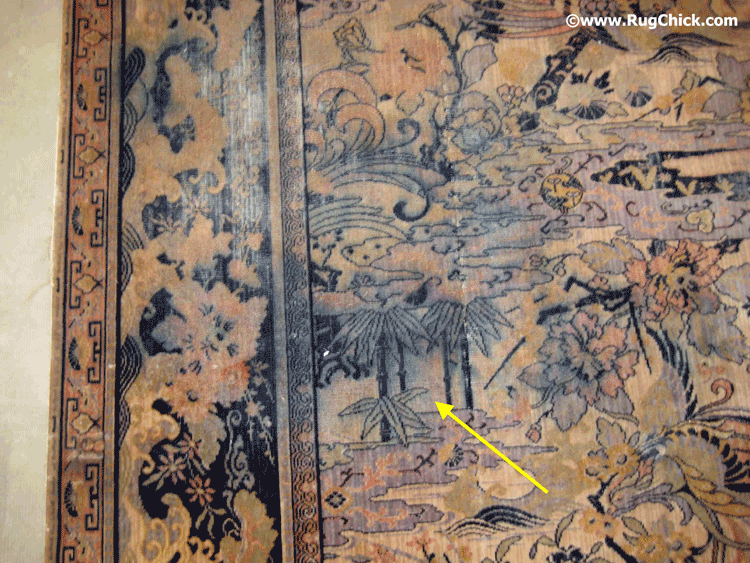
The red dye crocks on to a damp towel.
The careless cleaner approaches a rug as if they are all the same. “Wool is wool, what’s the big deal?”
Most don’t bother to do a dye test. Why? Honestly, I’m not sure why. It should be done on every rug, and it only takes a few minutes. This can be done with a high pH solution, or my personal preference of testing with hot water in a small area on the front AND the back.
Other careless cleaners do in fact do the dye test, but then they think if they use a dye stabilizing or dye locking solution that the rug becomes bulletproof to bleeding on them. That’s just not true, especially if the rug has colors that crock on a towel during a dry or damp towel.
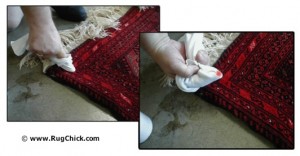
The red dye crocks on to a damp towel.
When color crocks on to a cotton towel when it’s dry, or when it’s just damp, this is a serious problem. Especially if the color is a dark one.
In the case above, this is a tribal woven rug from Afghanistan. In some tribal areas, especially war-torn ones like in this weaving region, water is not always readily accessible to provide the thorough washing and scouring of the wool to remove the excess dyes and other impurities from the wool. So you have a rug that has some excess dye in the wool, that is going to move when it gets wet with a wash, so you better be seriously skilled to be able to handle that when it happens.
But sometimes the crocking is not from excess dye, but from color that has been added AFTER the rug was woven.
We call these rugs over-dyed rugs, and you will see these types of rugs come in two types:
1) TEA WASHED RUGS
A large number of rugs today, especially coming out of India, Pakistan, and China, are being given a tea wash treatment. This is a brown dye that is sometimes called henna wash, or also called having your rug “antiqued,” because it gives the rug a more muted look which makes it look older.
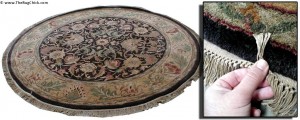
India tea washed rug
The tones vary from browns to golds to yellows. They make the rug darker, and also make the white cotton fringes beige or brown.
The better quality rugs are properly soaked in the dye to allow for even application, or are given multiple layers of application to ensure a good saturation and bonding of the tea wash dye to the rug fibers.
The lesser quality applications are sprayed on, usually on just one side, and it is often these lesser quality treatments that will crock on a dye test. This means that no matter how gentle you are with your cleaning process that over-dye is coming off. It’s like a spray-on fake tan… good until it’s time to take a shower.
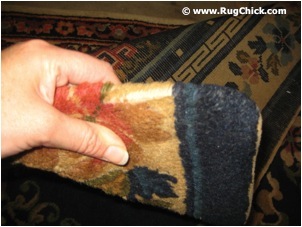
Grin open the fibers and you see the bad tea wash job.
When you grin open the fibers you can see if there has been an over-dye treatment with tea wash. You can also see it on the fringe tassels by untwisting them to see if there is white under the beige tone.
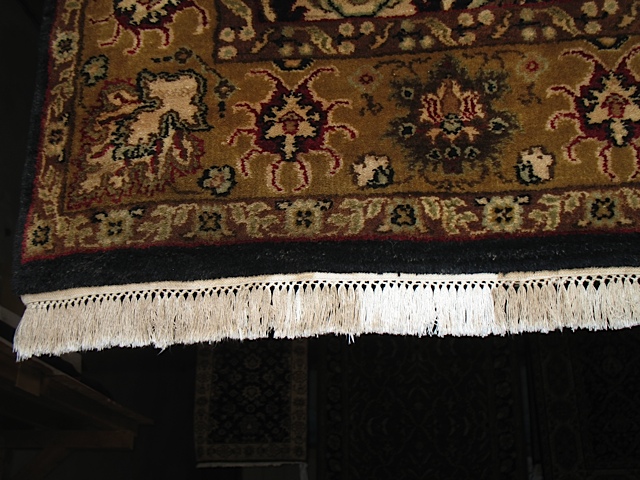
Cleaning the fringe removes the tea wash dye on some.
And while you are closely inspecting the rug, look also for other pre-existing damage, because often a tea wash application is given to rugs to try to cover up damage such as pre-existing rug dye bleed or other stains.
It’s important to share with your client that the rug has been over-dyed with this tea wash treatment BEFORE you clean it, because likely some of it will come out no matter how gentle you are with your process. Especially if it crocks on you, that over-dye is coming off even if you choose a dry compound cleaning method.
But, at least it CAN be cleaned. You just need to share that this if it tests as a poorer quality application, that the rug has essentially been given a “spray-on tan” that needs to come off if they want it to be properly washed.
A much more perilous over-dye treatment isn’t dye at all… it’s ink.
2) INKED RUGS
Rug dealers for years have tried to hide small areas of damage on antique rugs with using India ink, or painting of worn areas to make them less noticeable.
Today this practice has unfortunately expanded to create some truly dangerous rugs.
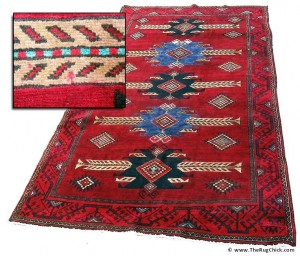
New Hamadan rug bought on-line, and covered in INK.
The rug above is an example of one of the dangers of buying a rug on-line on one of these mass market retailers. When you buy rugs locally, at least you get the opportunity to “try it before you buy it” and take it out on approval. But more importantly you can do things like take a handkerchief and do a little dye test in the store just to make sure you are not buying inferior goods.
For a rug cleaner, this rug would be a nightmare. Every single color of this rug has been colored over with ink, which is why it has that blotchy, dark look to it. And when you grin the fibers open you can see that there is dark ink on the tips of the fibers.
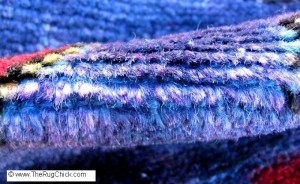
Tips of the fibers are purple ink, base of the fibers are blue.
Taking a completely DRY towel to the face of this rug picked up every single color.
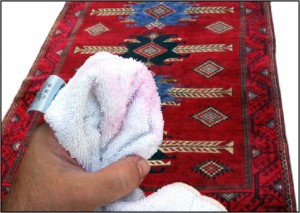
Dry towel picks up red from the rug easily.
Getting this rug even damp would make the inks pool together and make a mess not only of the rug, but of your wash floor.
So when you do your dye test on a rug, and it crocks, you want to investigate closely to see if it’s possibly ink applied to the fibers, because a dye stabilizing or locking solution is not going to do a thing for ink.
This rug, and others like it, is flawed product… and is not cleanable. And in the case of the rug being shown, the ink from the rug moved on to the underneath wall-to-wall carpeting which led to a much more expensive problem for the owner to handle.
Today more than ever, with the push to cut corners on production costs and get rugs to market faster and cheaper, there are more traps for rug cleaners today than ever before.
But if you are careful, and very thorough with your fiber and dye tests, and your pre-inspection checklists, then you can avoid the biggest rug disasters out there.
Happy Rug Cleaning!
– Lisa
